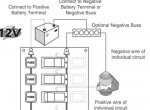Fox_Red131
Cadet
- Joined
- Nov 5, 2010
- Messages
- 14
Hey everyone,
Well, it's freezing here in KY but I've got the fever to be on the water. Just celebrated a birthday and got the hookup from some family (new CD player and switch panel) for the boat! Needless to say I'm pumped to get rolling on everything. Here's where I need some guidance. Right now I run a mess of wires with inline fuses back to the battery so I got this 6 accessory panel from Seasense. It has all the connections on a buss in the back and as per directions it wants a separate negative buss. The leads off the switch panel for (+) and (-) must be a 16 or 18 g wire...it's small. My question is what would be the best way of doing this with adequate wire gauge going from the battery to my new panel in particular? I understand the lingo fairly well, so any advice is great. Thanks guys.
Well, it's freezing here in KY but I've got the fever to be on the water. Just celebrated a birthday and got the hookup from some family (new CD player and switch panel) for the boat! Needless to say I'm pumped to get rolling on everything. Here's where I need some guidance. Right now I run a mess of wires with inline fuses back to the battery so I got this 6 accessory panel from Seasense. It has all the connections on a buss in the back and as per directions it wants a separate negative buss. The leads off the switch panel for (+) and (-) must be a 16 or 18 g wire...it's small. My question is what would be the best way of doing this with adequate wire gauge going from the battery to my new panel in particular? I understand the lingo fairly well, so any advice is great. Thanks guys.





















